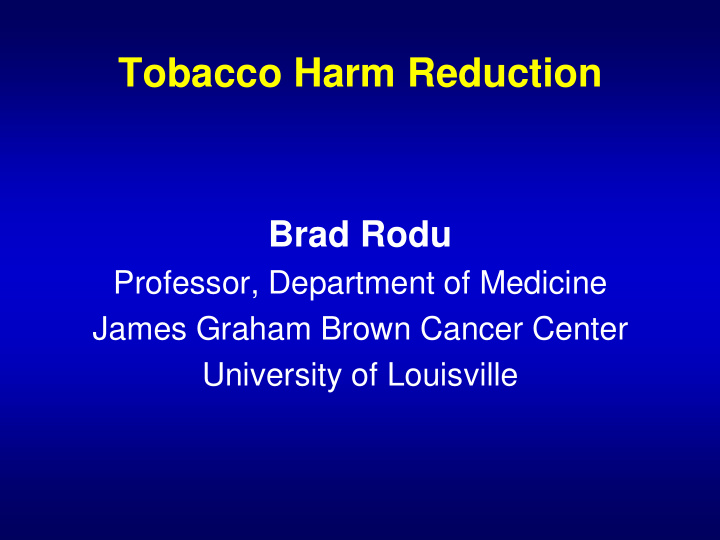



Tobacco Harm Reduction Brad Rodu Professor, Department of Medicine James Graham Brown Cancer Center University of Louisville
The Smoking Status Quo: Unacceptable • The American Anti-Smoking Campaign is 45 Years Old • According to the CDC: 45 million smokers in the U.S. 443,000 deaths every year in the U.S. 5,800 in Oklahoma
Lung Cancer (ICD 161-162) Mortality in Men and Women Age 35+, Oklahoma and the US, 1979-2009 250 OK Men 200 Deaths per 100,000 py 150 US Men OK Women 100 US Women 50 0 Year
If the Status Quo Continues In the next 20 years: • 8 million Americans will die from smoking All are adults over 35 years of age None of them are now children
The Failed Anti-Smoking Campaign • The Campaign’s Only Message: Quit Nicotine and Tobacco, or Die • The Campaign’s Only Quitting Tactics: Ineffective Behavioral Therapy Ineffective Use of Nicotine Rodu and Cole. Technology 6: 17-21, 1999. Rodu and Cole. International J Cancer 97: 804-806, 2002.
The Anti-Smoking Campaign- Behavioral Therapy • NCI Manual for Physicians- Counsel Patients to: – ”Keep your hands busy - doodle, knit, type a letter” – ”Cut a drinking straw into cigarette -sized pieces and inhale air” – ”Keep a daydream ready to go” Source: How to help your patients stop smoking. NIH Pub. No. 93-3064, 1993
The Anti-Smoking Campaign- Faulted Use of Nicotine • Temporary – 6 to 12 weeks • Expensive – per unit and per box • Very Low Dose – unsatisfying for smokers • 7% Success* – ”Efficacious”, ”Modest” *Hughes et al. Meta-analysis in Tobacco Control, 2003.
Comparing Nicotine to Caffeine Addictive Drugs Can Be Used Safely Properties of Nicotine and Caffeine Pleasurable Effects: Enhance concentration and performance Provide a sense of well being Elevate mood Powerfully Addictive: Irreversible for many consumers Can be Used Safely: Do not cause Cancer, Emphysema, Heart Diseases Delivery Systems: Caffeine- Coffee, tea, cola drinks Nicotine- Smoke versus smokeless
Tobacco Harm Reduction Permanent Nicotine Maintenance Smokeless Tobacco • Nicotine levels comparable to smoking • Vastly safer than smoking (>98%) • Evidence from Sweden – and the U.S. – that smokeless works • Modern products are socially acceptable
American Smokeless Tobacco Chewing Tobacco Moist Snuff Powdered Dry Snuff
Smokeless Tobacco Use is 98% Safer Than Smoking • No risk for emphysema, lung cancer, and heart disease • Mouth cancer risk - Very low in absolute terms* * 22 studies over 50 years: Rodu and Cole, Oral Surgery 2002.
Smokeless Tobacco and Health: Oral Cancer Relative Risks Smoking ~10 Alcohol Abuse ~4 American Smokeless Tobacco* Chewing tobacco 1.2 Moist snuff 1.0 Powdered Dry Snuff 4.0 Incidence Rate in Long-term ST users (At RR=4): 26 per 100,000 person-years (py)** * Over 20 epidemiologic studies, reviewed in: B Rodu, P Cole. Oral Surgery 93: 511-515, 2002. **New England Journal of Medicine 304: 745-749, 1981.
Comparing Risks of Smokeless Tobacco, Automobiles and Cigarettes Annual Death Rate from: Powdered dry snuff 1 12 per 100,000 users Automobiles 2 11 per 100,000 users Cigarettes 3 > 600 per 100,000 users 1. New England Journal of Medicine, 1981. 2. National Highway Traffic Safety Administration, 2009. 3. American Cancer Society data, 1999.
Smokeless Tobacco Has Worked For Swedish Men For 50 Years • High rate of smokeless tobacco use. • Lowest smoking rate in Europe. • Lowest rate of lung cancer and other smoking- related diseases in Europe • If EU men smoked at the rate of Swedish men, almost 274,000 lives per year would be saved* *B Rodu and P Cole. Scandinavian Journal of Public Health , 2009.
Tobacco Use in Northern Sweden From J Int Med 2002; Scand J Pub Health 2005 45 Men 40 35 Snus Women 30 25 Percent 20 15 10 Smoking 5 0 1986 1990 1994 1999 2004 1986 1990 1994 1999 2004 Year
Growing Discussion about Tobacco Harm Reduction 2002 Royal College of Physicians Report ”...[smokeless] tobacco...10 to 1,000 times less hazardous than smoking...some manufacturers want to market ST as a harm reduction option...may find support for that in the public health community” 2007 Royal College of Physicians Report Smokers smoke predominantly for nicotine,…nicotine itself is not especially hazardous. Harm reduction - a fundamental component of many aspects of medicine and…everyday life…has not been applied to smoking. - has the potential to save millions of lives, and deserves consideration.
Growing Discussion about Tobacco Harm Reduction 2006 Addictive Behaviors , NCI Funded “…4 million [American] smokers would switch to the low - carcinogen smokeless tobacco.” American Council on Science and Health Harm Reduction Journal , 2006 and 2011 ”.... there is a strong scientific and medical foundation for tobacco harm reduction, which shows great potential as a public health strategy to help millions of smokers.”
Tobacco Harm Reduction The Owensboro, KY Campaign
E-cigarettes
Tobacco Harm Reduction: Take-Homes • Eliminate misinformation on state government tobacco web pages such as: “smokeless tobacco doesn’t mean harmless tobacco…One can of chew equals about four packs of cigarettes…an almost instant addiction… Smokeless tobacco is not a safe replacement for smoking cigarettes” • Don’t ”equalize” taxes on smokeless tobacco with those on cigarettes: it denies smokers affordable options • State employee smokers who switch save essentially as many health care dollars as smokers who quit • Set insurance rates that don’t penalize smokers who switch
For More Information www.smokersonly.org Rodutobaccotruth.blogspot.com www.SwitchandQuitOwensboro.org
Recommend
More recommend